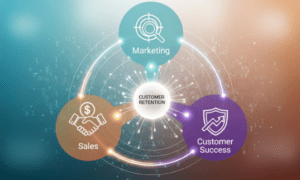Now more than ever, customers expect interactions with a company to be contextual, timely, consistent, and relevant.
These interactions can range from providing proactive notifications of a postponed event to cross-selling relevant offers provided by a retail salesperson.
The decisions that orchestrate the interactions are more valuable when presented in real-time.
The best way to interact with the customer needs to be selected at that given moment in the journey. Making that decision as part of a batch process will cripple your results. Why? It fails both the relevancy and timeliness test. What was true for a customer yesterday may no longer be true today.
What is Next-Best-Action Marketing?
Next-best-action (NBA) marketing is a proven marketing technology that fulfills the requirements of delivering omnichannel, relevant, contextual, and consistent messages. NBA marketing technologies combine predictive analytics and business rules in determining the best content to present to a single customer or prospect.
The first step in building out a suite of NBAs for your organization is defining a set of propositions.
How Does Your Company’s Value Proposition Differ from a Set of NBA Propositions?
A value proposition carries the central message of the company. It embodies the value a company promises to deliver to customers, should they choose to buy its product or remain a customer.
It’s your “why” statement or brand promise.
A set of NBA propositions is made up of the offers, statements, and actions that you recommend to customers. They support the relationship between you and your customer, underscoring and reinforcing the value proposition. They are impactful at a point in time, when your company is aware of the context of the interaction and can serve up the NBA proposition.
Next-best-action marketing aims to predict and deliver the most valuable proposition from both a customer and company perspective. It should be remembered that “value” encompasses variables that are both quantitative and qualitative. The quantitative aspect is usually driven by the business, while the qualitative side is driven by context awareness, individual preferences, behavioral data, and propensity models (more on this later).
Here are a few examples of propositions for existing customers:
A new Apple customer who has just purchased the latest iPhone
“So, you have a new iPhone. Enjoy a peaceful night’s sleep with the comfort blanket of Apple care insurance.”
An Uber customer
“Enter this special code in the Uber Eats app to unlock your promo.”
“Buy one get, one free on Uber Eats!”
What’s the Difference Between Journeys and Next-Best-Action Marketing Propositions?
The customer journey is all the touchpoints a customer has with your company.
Instead of looking at a final conversion, the customer journey includes all the experiences, before and after the conversion. NBA propositions are embedded within journeys.
Next-best-action marketing leverages predictive models to deliver the most relevant, timely, and valuable offers and messages to customers across channels. By understanding audience journeys and tailoring propositions to awareness, acquisition, and retention goals, brands can have consistent, contextual interactions that reinforce their value proposition
What follows are the basic examples of how NBA propositions and journeys intertwine:
Awareness Journey
The proposition is aimed at exposing the consumer to the brand at opportune moments to increase familiarity.
An example is “Uber – The Smartest Way to Get Around.”
Acquisition Journey
The proposition message is designed to change a prospect into a customer.
An example is “Get 15% off your first ride in NYC with Uber!”
In-life Journey
In-life propositions are aimed at established customers. The goal of this type of journey is to keep the relationship fresh by rewarding loyalty.
An example is “Thank you for your business, receive a free upgrade on your next car rental.”
Retention
A retention proposition aims to persuade high churn-risk customers or those who have requested to leave, to stay.
An example is “Save $25 per month when you renew for one year.”
Win-back
If a customer leaves an organization, the goal of the win-back proposition is to persuade them to return.
“We miss you, take $15 off when you order your next meal delivery.”
Propositions are usually organized within these categories and clearly relate them to the underlying business issues being addressed. The journey framework also provides us with a foundation for how to structure eligibility rules.
For example: Prospects should only be shown awareness or consideration propositions.
Customers who have been members for over two years with a low propensity to churn should only be shown in-life propositions, and when an action was taken to trigger a relevant offer.
A first-class customer experience requires that omnichannel interactions are relevant, timely, and consistent. Next-Best-Action Marketing provides the technology and methodology frameworks to satisfy these requirements.
Next best action marketing leverages predictive analytics and business rules to determine the most relevant content to deliver to customers and prospects at the right time. By combining data on individual preferences, context, and propensity models, companies can provide timely, consistent, and personalized omnichannel experiences.
Using digital business cards to consolidate your multi-channel content marketing efforts is an essential step. Using retargeting to reach your past customers and site visitors is another great idea. Don’t forget to segment your audience to plan your campaigns better. Establishing your brand as an active part of the niche community is fundamental.
Implementing Next-Best-Action Marketing requires defining audience journeys and value propositions tailored to awareness, acquisition, retention, and other goals. Overall, Next-Best-Action Marketing enables brands to have meaningful and valuable interactions that reinforce their central value proposition.
Key Takeaways:
- Next Best Action Marketing aims to predict and deliver the most valuable proposition to customers or prospects based on quantitative value and qualitative context.
- NBA propositions differ from a company’s central value proposition in that they represent contextual offers and actions to support the customer relationship.
- NBA propositions are embedded within customer journeys spanning awareness, acquisition, in-life experience, retention, and win-back.
- Effective implementation requires defining eligibility rules so prospects, new customers, and loyal customers all receive relevant NBA propositions.
- Omnichannel personalization, timeliness, and consistency are key benefits of Next-Best-Action marketing when implemented properly.



































